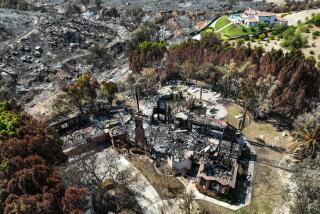PG&E; Launches $2-Billion Energy-Saving Program : Utilities: The plan, billed as the nation’s biggest such effort, aims to encourage customers of the San Francisco firm to use more efficient lighting, equipment and appliances.
Pacific Gas & Electric Co. on Wednesday launched a $2-billion, 10-year program aimed at promoting more efficient energy use and avoiding the need to build costly new power plants.
Billed as the nation’s biggest such effort, the program follows last summer’s approval by the California Public Utilities Commission of a far-reaching conservation plan that gives the state’s four largest electric and natural gas utilities incentives to save energy. The primary idea is to encourage residential and commercial customers to conserve energy by using more efficient lighting, equipment and appliances.
“The world today demands a totally different approach” to energy usage, said Richard A. Clarke, PG&E;’s chairman and chief executive. “The air we breathe and the water we drink are threatened (by pollution).” The Persian Gulf War, he added, “points up the imperative of reducing our dependence on Mideast oil.”
With the dedication Wednesday of what is slated to become a $7.5-million, state-of-the-art facility for demonstrating and developing energy-efficient technologies, PG&E; emerged as the forerunner in an effort to save rather than use energy, said Ralph Cavanagh, energy program director for the Natural Resources Defense Council, a national environmental group.
“California is doing what the federal government should be doing,” said Cavanagh, who helped devise PG&E;’s program. “The White House thinks that conservation has to mean sacrifice, but Californians understand abundantly that that isn’t so.”
The renewed push toward decreasing energy use grew out of a 1989 study showing that California’s utilities had drastically reduced spending on such programs. Utility officials at the time acknowledged that plentiful and cheap energy had made conservation efforts less economical.
The uncertainty of oil supplies and growing concern about the burning of fossil fuels caused a resurgence of interest. Last January, under orders from the PUC, a coalition of utilities and environmental and consumer groups put together a statewide strategy for saving energy.
In 1991, PG&E; plans to spend $147 million on “customer energy efficiency” programs, Clarke said. Over the decade, the goal is to meet 75% of the expected growth in demand for electricity, offsetting the need to burn the equivalent of 68 million barrels of oil.
By comparison, Southern California Edison Co. is spending $60 million this year on energy efficiency programs and has applied to the PUC to raise that to $100 million a year in 1992, 1993 and 1994. Southern California Gas Co. is spending about $56 million this year. The much smaller San Diego Gas & Electric Co. has earmarked $25 million a year.
“We’re seeking 2,500 megawatts in savings,” said Clarke of PG&E;’s efforts. “That would easily be a $2.5-billion power plant.”
At the heart of the energy-saving efforts by PG&E; and other utilities have been rebates to residential and commercial customers who install insulation and other energy-saving devices.
PG&E; also is underwriting a $10-million study at its San Ramon, Calif., research facility to identify economical ways to improve energy efficiency.
Wednesday’s ceremony took place in a run-down building south of Market Street that once housed the San Francisco Progress newspaper. By year-end, PG&E; said, it is to be transformed into the Pacific Energy Center, where builders, architects, contractors and building owners will be able to attend workshops and view energy-saving devices and systems.
“This will be the showcase that helps customers learn about options,” said Amory Lovins, an energy expert based in Colorado, who attended the event and is on the center’s advisory board.
PG&E; is the state’s largest utility, with 4.2 million electric customers and 3.2 million natural gas customers in Northern and Central California. It is also the nation’s largest investor-owned utility.
Under the efficiency programs approved by the state PUC, PG&E; shareholders stand to benefit handsomely from the utility’s efforts. They will receive 15 cents for every dollar saved. The remaining 85% in savings is to be passed on to customers. PG&E; said it expects to report pretax earnings from the 1991 programs of more than $30 million.
In the short term, however, customers will be paying slightly higher rates to cover the costs of the energy efficiency programs. But PG&E; noted that customers can reduce their monthly bills by weather-stripping their homes, using low-power light bulbs and replacing old appliances, all of which qualify for rebates.
San Francisco, Cavanagh noted, is emerging as an energy-efficiency center. Earlier this month, the city became home to the Energy Foundation, the nation’s first grants-making foundation devoted to energy conservation. It is funded by the Rockefeller Foundation, the John D. and Catherine T. MacArthur Foundation and Pew Charitable Trusts.
SAVING MONEY AND POWER Energy savings of common energy efficiency improvements (very high efficiency models versus average older, inefficient models)
Annual Annual High efficiency energy bill appliance/device savings* savings Refrigerator (12.5% above standards, 20 cubic foot) 1,100 kwh $110 Central air conditioner (SEER 12 vs. SEER 6, 3-ton unit) 2,055 kwh $267 Ceiling insulation Homes with air conditioning 1,652 kwh $215 Homes with gas space heating 161 therms $137 Low-flow showerhead Electric water heating 883 kwh $88 Gas water heating 41 therms $23 Water heater blanket Electric water heating 353 kwh $35 Gas water heating 21 therms $12 Fluorescent lamps (75 watt incandescent vs. 18 watt fluorescent) 83 kwh $8
Percent High efficiency PG&E; engery appliance/device rebate savings* Refrigerator (12.5% above standards, 20 cubic foot) $50 55% Central air conditioner (SEER 12 vs. SEER 6, 3-ton unit) $400 50% Ceiling insulation Homes with air conditioning $100 -- Homes with gas space heating $100 -- Low-flow showerhead Electric water heating $4 50% Gas water heating $4 50% Water heater blanket Electric water heating $5 10% Gas water heating $5 10% Fluorescent lamps (75 watt incandescent vs. 18 watt fluorescent) $7 76%
Cost of high efficiency High efficiency appliance/ appliance/device device** Payback Refrigerator (12.5% above standards, 20 cubic foot) $700 6 years Central air conditioner (SEER 12 vs. SEER 6, 3-ton unit) $2,500 8 years Ceiling insulation Homes with air conditioning $700 3 years Homes with gas space heating $700 4 years Low-flow showerhead Electric water heating $9 year or less Gas water heating $9 year or less Water heater blanket Electric water heating $10 year or less Gas water heating $10 year or less Fluorescent lamps (75 watt incandescent vs. 18 watt fluorescent) $12 year or less
*Savings based on old inefficient unit vs. new efficient unit
**Cost based upon the cost for the efficient unit
***Payback based upon cost of efficient unit minus PG&E; rebate divided by annual energy savings. Payback is actually quicker when taking into account rising energy price in future years.
Source: Pacific Gas & Electric Co.
More to Read
Inside the business of entertainment
The Wide Shot brings you news, analysis and insights on everything from streaming wars to production — and what it all means for the future.
You may occasionally receive promotional content from the Los Angeles Times.







